
Archaeopteryx, sometimes referred to by its German name, "Urvogel" is a genus of bird-like dinosaurs. The name derives from the ancient Greek ἀρχαῖος (archaīos), meaning "ancient", and πτέρυξ (ptéryx), meaning "feather" or "wing". Between the late 19th century and the early 21st century, Archaeopteryx was generally accepted by palaeontologists and popular reference books as the oldest known bird. Older potential avialans have since been identified, including Anchiornis, Xiaotingia, and Aurornis.

In biology, a type is a particular specimen of an organism to which the scientific name of that organism is formally associated. In other words, a type is an example that serves to anchor or centralizes the defining features of that particular taxon. In older usage, a type was a taxon rather than a specimen.
Liopleurodon is an extinct genus of carnivorous pliosaurid pliosaurs that lived from the Callovian stage of the Middle Jurassic to the Kimmeridgian stage of the Late Jurassic period. The type species is L. ferox, which is probably the only valid species. Some studies also include the second species L. pachydeirus, but this latter is considered as a probable junior synonym of L. ferox due to its lack of viable diagnosis. As the holotype specimen of L. ferox consists of a single tooth preserving questionable distinctive features, recent studies therefore recommend the necessary identification of a neotype in order to preserve the validity of the genus. Numerous fossil specimens attributed to Liopleurodon, even including numerous skeletons, have been discovered in Europe, Russia, and Mexico. Other additional species were even proposed, but these are currently seen as coming from other pliosaurid genera.
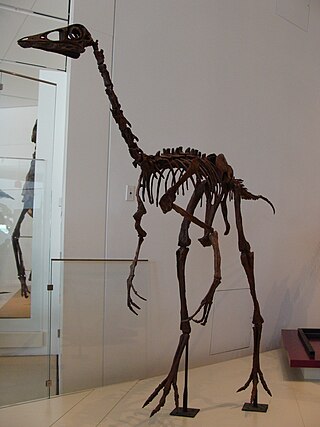
Ornithomimus is a genus of ornithomimid theropod dinosaurs from the Campanian and Maastrichtian ages of Late Cretaceous Western North America. Ornithomimus was a swift, bipedal dinosaur which fossil evidence indicates was covered in feathers and equipped with a small toothless beak that may indicate an omnivorous diet. It is usually classified into two species: the type species, Ornithomimus velox, and a referred species, Ornithomimus edmontonicus. O. velox was named in 1890 by Othniel Charles Marsh on the basis of a foot and partial hand from the Denver Formation of Colorado. Another seventeen species have been named since then, though almost all of them have been subsequently assigned to new genera or shown to be not directly related to Ornithomimus velox. The best material of species still considered part of the genus has been found in Alberta, representing the species O. edmontonicus, known from several skeletons from the Horseshoe Canyon Formation. Additional species and specimens from other formations are sometimes classified as Ornithomimus, such as Ornithomimus samueli from the earlier Dinosaur Park Formation.

In zoology and botany, a paratype is a specimen of an organism that helps define what the scientific name of a species and other taxon actually represents, but it is not the holotype. Often there is more than one paratype. Paratypes are usually held in museum research collections.
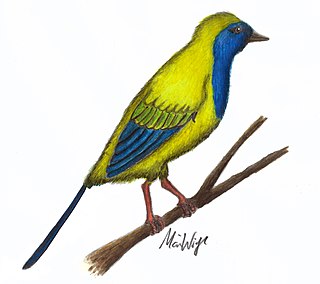
Liaoxiornis is a dubious genus of enantiornithine bird. The only named species is Liaoxiornis delicatus, described by Hou and Chen in 1999. Because the species was named for a hatchling specimen, it cannot be matched with adult specimens, and so it is impossible to determine which, if any, birds from the same rocks represent adults of this species. Luis Chiappe and colleagues therefore regarded it as a nomen vanum or at least a nomen dubium, and recommended that use of the name be abandoned.
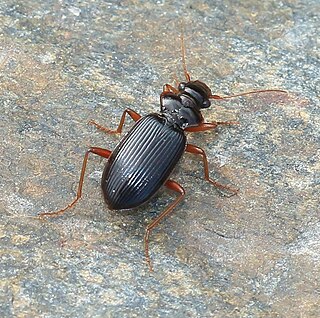
Leistus is a genus of ground beetles in the family Carabidae. There are more than 250 described species in Leistus, found in the Holarctic.

Leistus terminatus is a species of ground beetle that is native to the Palearctic realm and Europe, where it can be found in countries like Austria, the Baltic states, Benelux, Great Britain including the Isle of Man, the Czech Republic, mainland France, Germany, Hungary, the Republic of Ireland, mainland Italy, North Macedonia, Northern Ireland, mainland Poland, Romania, Scandinavia, Slovakia, Slovenia, Switzerland, and eastern Europe.

Leistus spinibarbis is a species of ground beetle in the family Carabidae. It is found in the Palearctic, including North Africa.

Leistus ferrugineus is a species of ground beetle in the family Carabidae. It is found in the Palearctic and northeastern North America.

Leistus fulvibarbis is a species of ground beetle of the subfamily of Nebriinae. Nominative subspecies is distributed in Europe, Asia Minor and North Africa; L. f. danieli found in Italy. They live in forests, bushes, trees and woodlands. Body length of an adult: 6.5–8 millimetres (0.26–0.31 in). Beetle is black colored, with blue metallic shiny elytra. Appendages are reddish-yellow.
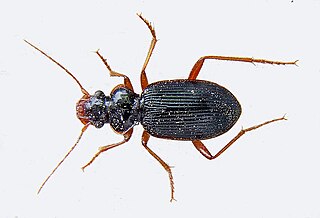
Leistus rufomarginatus is a species of ground beetle that is native to Europe where it can be found in the following regions: Albania, Austria, the Baltic states, Benelux, Great Britain including the Isle of Man, the Czech Republic, Denmark, France, Germany, Greece, Hungary, the Republic of Ireland, Italy, Liechtenstein, Moldova, Northern Ireland, mainland Poland, Romania, Slovakia, Sweden, Switzerland, Ukraine, the states of former Yugoslavia, and European part of Turkey.

Diluvicursor is a genus of small ornithischian from the Lower Albian of Australia. It is known from one species, the type species D. pickeringi. The two known specimens, a vertebra and a partial juvenile postcranium discovered in 2005 from the Eumeralla Formation, are known, and they were named in early 2018.
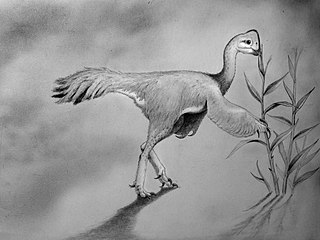
Leptorhynchos is an extinct genus of caenagnathid theropod from the Late Cretaceous of what is now the US state of Texas, although it has been suggested to also exist in Alberta and South Dakota. The type species is L. gaddisi, and it is currently the only widely accepted valid species. The generic name of Leptorhynchos comes from the Greek "leptos" meaning "small" and "rhynchos" meaning "beak". The specific epithet is in honor of the Gaddis family, who owned the land on which the holotype was discovered.
Leistus montanus is a species of ground beetle native to Europe.
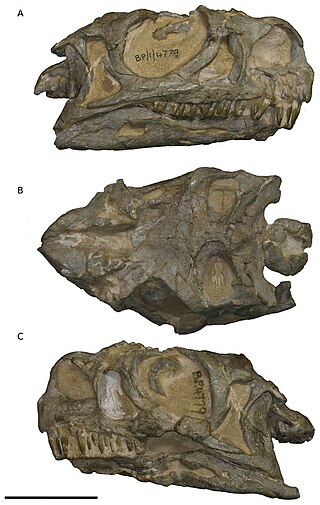
Ngwevu is a genus of massospondylid sauropodomorph dinosaur from the Lower Jurassic of South Africa. The genus contains one species, Ngwevu intloko.
Leistus lebardicus is a species of ground beetle found in Lebarde, Georgia. It is in the subgenus Leistus.
Leistus darvazicus is a species of ground beetle that can be found in the Darvazskiy Mountain Range, Tajikistan. It belongs to the subgenus Pogonophorus.
Leistus trabzonicus is a species of ground beetle found south of Uzongöl, Trabzon Province, Turkey. It belongs to the subgenus Leistus.
Leistus janae is a species of ground beetle that can be found in Russia, far east, on Mt. Oblachnaya. It belongs to the subgenus Leistus.













